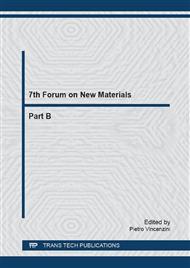[1]
M. J. Allen, V. C. Tung, R. B. Kaner, Honeycomb Carbon: A Review of Graphene, Chem. Rev. 110 (2010) 132-145.
DOI: 10.1021/cr900070d
Google Scholar
[2]
D. Akinwande, N. Petrone, J. Hone, Two-Dimensional Flexible Nanoelectronics, Nat Commun 5 (2014) 1-12.
DOI: 10.1038/ncomms6678
Google Scholar
[3]
A. I. Shkrebtii, J. L. Cabellos, N. Arzate, B. S. Mendoza, P. McNelles, Nonlinear optical characterization of hydrogenated two-dimensional honeycomb carbon (graphene), silicon (silicene) and germanium layer, 7th International Symposium on Ultrafast Surface Dynamics (USD7) Croatia Brijuni Island, 22-26 Aug. (2010).
Google Scholar
[4]
A. I. Shkrebtii, E. Heritage, P. McNelles, J. L. Cabellos, B. S. Mendoza, Graphene and Graphane Functionalization with Hydrogen: Electronic and Optical Signatures. Phys. Status Solidi C 9 (2012) 1378-1383.
DOI: 10.1002/pssc.201100705
Google Scholar
[5]
J. L. Cheng, C. Salazar, J. E. Sipe, Optical Properties of Functionalized Graphene. Phys. Rev. B 88 (2013) 045438-1-6.
Google Scholar
[6]
R. Balog, B. Jorgensen, L. Nilsson, et al, Bandgap Opening in Graphene Induced by Patterned Hydrogen Adsorption, Nat Mater 9 (2010) 315-319.
Google Scholar
[7]
M. Pumera, C. H. A. Wong, Graphane and Hydrogenated Graphene, Chem. Soc. Rev. 42 (2013) 5987-5995.
DOI: 10.1039/c3cs60132c
Google Scholar
[8]
Z. Sofer, O. Jankovsky, P. Simek, L. Soferova, D. Sedmidubsky, M. Pumera, Highly Hydrogenated Graphene Via Active Hydrogen Reduction of Graphene Oxide in the Aqueous Phase at Room Temperature, Nanoscale 6 (2014) 2153-2160.
DOI: 10.1039/c3nr05407a
Google Scholar
[9]
R. Zapata-Pena, S. M. Anderson, B. S. Mendoza, A. I. Shkrebtii, Nonlinear Optical Responses in Hydrogenated Graphene Structures, physica status solidi (b) 253 (2016) 226-233.
DOI: 10.1002/pssb.201552565
Google Scholar
[10]
O. Leenaerts, B. Partoens, F. M. Peeters, Hydrogenation of Bilayer Graphene and the Formation of Bilayer Graphane from First Principles, Phys. Rev. B 80 (2009) 245422-1-6.
DOI: 10.1103/physrevb.80.245422
Google Scholar
[11]
A. I. Shkrebtii, J. L. Cabellos, E. Heritage, I. M. Kupchak, D. V. Korbutyak, in XI International Conference on Nanostructured Materials NANO2012, 26-31 Aug. 2012, Rhodes, Greece, Rhodes, Greece, 26-31 Aug. (2012).
Google Scholar
[12]
L. Ci, L. Song, C. Jin, D. Jariwala, et al, Atomic Layers of Hybridized Boron Nitride and Graphene Domains, Nat Mater 9 (2010) 430-435.
DOI: 10.1038/nmat2711
Google Scholar
[13]
O. V. Yazyev, Y. P. Chen, Polycrystalline Graphene and Other Two-Dimensional Materials, Nat Nano 9 (2014) 755-767.
Google Scholar
[14]
L. Kou, C. Chen, S. C. Smith, Phosphorene: Fabrication, Properties, and Applications, The Journal of Physical Chemistry Letters 6 (2015) 2794-2805.
Google Scholar
[15]
S. Balendhran, S. Walia, H. Nili, S. Sriram, M. Bhaskaran, Elemental Analogues of Graphene: Silicene, Germanene, Stanene, and Phosphorene. Small 11 (2015) 640-652.
DOI: 10.1002/smll.201402041
Google Scholar
[16]
M. P. Levendorf, C. Kim, L. Brown, et al, Graphene and Boron Nitride Lateral Heterostructures for Atomically Thin Circuitry, Nature 488 (2012) 627-632.
DOI: 10.1038/nature11408
Google Scholar
[17]
C. R. Woods, L. Britnell, A. Eckmann, et al, Commensurate-Incommensurate Transition in Graphene on Hexagonal Boron Nitride, Nat Phys 10 (2014) 451-456.
Google Scholar
[18]
Quantum Espresso, Integrated Open-Source computer codes for electronic-structure calculations and materials modeling at the nanoscale. URL http: /www. quantum-espresso. org, (2016).
Google Scholar
[19]
P. Giannozzi, S. Baroni, Density-Functional Perturbation Theory, in: S. Yip (Ed. ), Handbook of materials modeling, Springer, Dordrecht, 2005, pp.196-214.
DOI: 10.1007/978-1-4020-3286-8_11
Google Scholar
[20]
R. N. Barnett, U. Landman, Born-Oppenheimer Molecular-Dynamics Simulations of Finite Systems: Structure and Dynamics of H2O, Phys. Rev. B 48 (1993) 2081-(2097).
Google Scholar
[21]
P. Cudazzo, C. Attaccalite, I. V. Tokatly, A. Rubio, Strong Charge-Transfer Excitonic Effects and the Bose-Einstein Exciton Condensate in Graphane, Phys. Rev. Lett. 104 (2010) 226804, 1-4.
DOI: 10.1103/physrevlett.104.226804
Google Scholar
[22]
A.I. Shkrebtii, et al, in preparation.
Google Scholar


